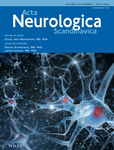Scattered cerebral infarction in the corona radiata predicts worse outcomes
Abstract
Objectives
Intracranial branch atheromatous disease often results in progressive motor deficits in the lenticulostriate arteries (LSA). In some patients with LSA infarction, magnetic resonance imaging (MRI) revealed single lesions at the LSA origin from the middle cerebral artery spreading in a scattered manner toward the distal area. This study aimed to elucidate the clinical characteristics of such cases.
Materials and Methods
This was a single-center, retrospective study comprising 1,840 consecutive patients admitted to the Ina Central Hospital, Japan. Two neurologists selected patients with LSA infarctions on the basis of MRI data. Patients with a single mass of infarct lesion from the origin were classified as the single group, whereas patients with infarct lesions as a single mass at LSA origin but divided and independent as the infarct area extended distally were classified as the scattered group. We compared the clinical characteristics and outcomes in these groups.
Results
The single and scattered groups included 119 and 35 patients, respectively. We defined worsening as an increase of one point or more on the National Institute of Health Stroke Scale. Univariate analysis demonstrated that patients in the scattered group showed significantly more worsening after hospitalization compared with those in the single group (48.6% vs. 28.6%; p < .05). Moreover, this can easily lead to increased disease severity (p < .016). In a multivariate analysis, group (odds ratio, 2.5 [95% CI, 1.11–5.74], p < .03) was an independent predictor of symptom worsening.
Conclusions
Scattered infarction in the corona radiata is an aggravating factor leading to worse outcomes.
CONFLICT OF INTEREST
None.
Open Research
DATA AVAILABILITY STATEMENT
Data supporting the findings of this study are available from the corresponding author upon reasonable request and with approval from the coauthors and the Ina Central Hospital ethics committee.




